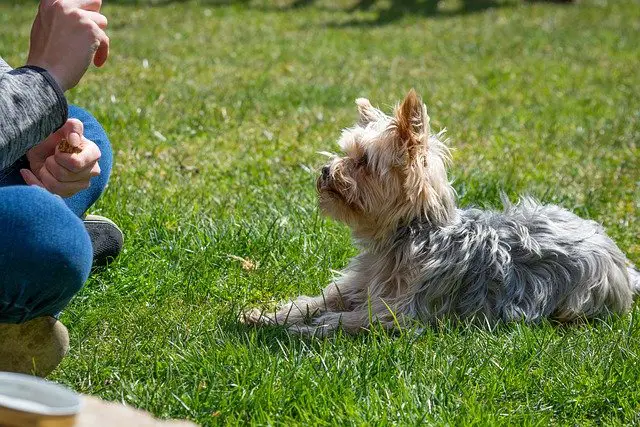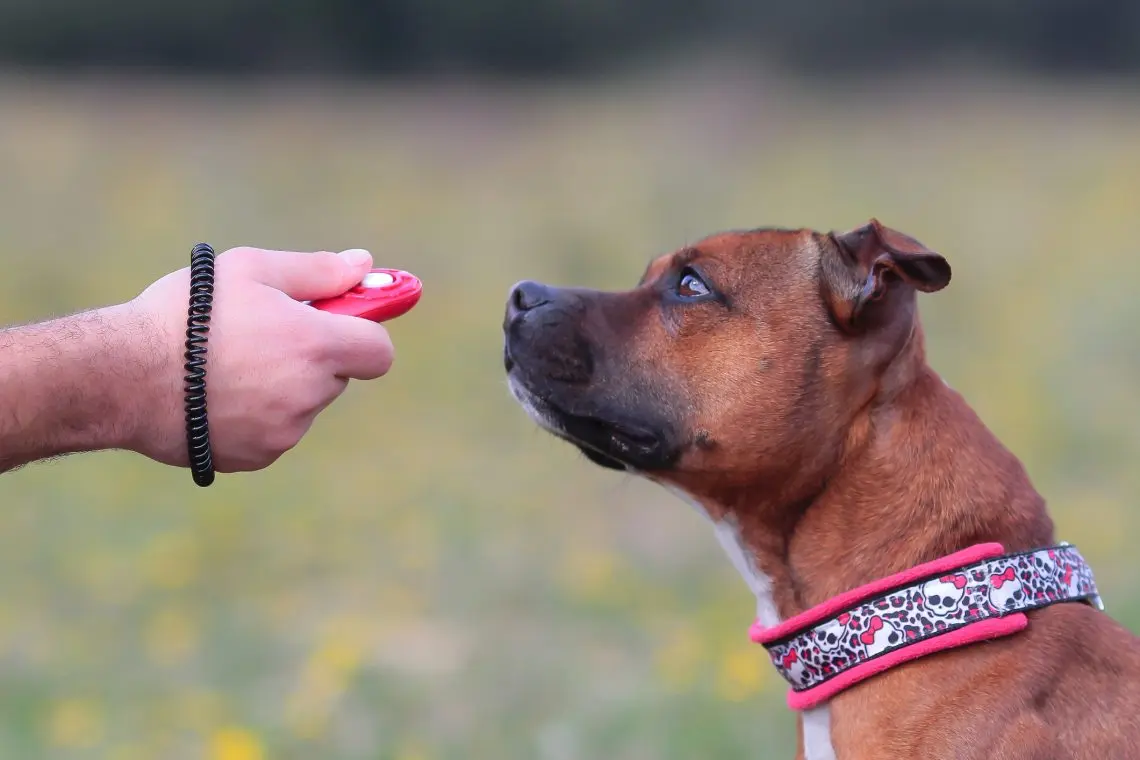There are numerous tools available for dog training. Two of these often used are the clicker and the whistle – but what is the difference between these two tools, and how are they used in dog training?
Some people assume that since both tools make a noise, they can be used interchangeably, but this is far from the truth! A whistle is a cue to your dog, while a clicker is an event marker and a reward predictor for a behavior your dog offered.
Dog whistles and clickers have been around for many years and can be extremely valuable in training, so long as you use them properly. Let’s discuss some of the situations you can use them in and training techniques for each of them.
Table of Contents
Clicker Training
Clickers were initially used in the early 1940s by Keller and Marian Breland (students of B.F. Skinner) and Bob Bailey at Animal Behavior Enterprise – but back then, the tools were known as “crickets.” They did not earn the name of “clicker” nor gain popularity until the 1980s when dog trainers began to shift more toward positive reinforcement techniques. The theory behind clicker training is based on studies conducted by Ivan Pavlov in the late 1800s. Pavlov showed that animals could learn to associate something that had no meaning to them (neutral stimulus) with something that they had strong feelings or responses to (unconditioned response). This connection would happen if that meaningless item or situation were presented immediately before the unconditioned response. Over time, the neutral stimulus would produce those same strong feelings on its own and become a conditioned response.
A clicker is a small device (usually plastic, metal, or a combination of the two) that makes a “click” sound when pressed. The click has no meaning to your dog; therefore, we consider it a neutral stimulus. We need to create a positive conditioned response to the click BEFORE we use it for training. In this case, you will teach the dog that the click sound means a reward will immediately follow. Once you have achieved the conditioned response to the click, the clicker becomes a secondary reinforcer, and we can use it to mark the exact moment that the dog performs the behavior we want.
Contrary to what some dog owners believe, you cannot merely purchase a clicker and expect your dog to respond to it.
You also should not click to get your dog to sit or perform any other command – the click needs to come AFTER the dog executes the command, and immediately BEFORE the reward. It is NOT an attention-getting device and should not be used as such if you want to have proper results. As I mentioned before, a clicker is used as an event marker and a reward predictor (also known as a secondary reinforcer), it does NOT tell your dog what to do. Clickers are typically used early on in training and faded from use as your dog learns what you expect from her.
How Do I Train My Dog Using a Clicker?
The first step is to create a conditioned response to the click sound. This step is crucial to your success! You will need your dog, your clicker, and several small treats that your dog loves – it is best to do this first step in a quiet area that your dog is familiar with, such as your living room or backyard. All you need to do is have your clicker in one hand and a treat in the other. Press the clicker and immediately give your dog a small treat. The treat hand should move toward your dog to deliver the reward immediately AFTER you press the clicker with your other hand. Repeat this process at least ten times. Remember, your dog does not have to do anything to earn her reward at this time! Do not ask her to sit or to watch you; just click and treat.

After you have completed your ten clicks with treats, it is time to see if it worked. Allow your dog to become slightly distracted. You can do this by having someone walk into the room or move something of low value around (toss a pillow to another couch). When your dog is looking away from you, press your clicker.
If your dog turns to look at you, immediately give a treat. If your dog responded to the click by looking at you and expecting the treat, you have created the conditioned response you wanted! If your dog does not respond to the click, you will need to repeat the click and treat routine several more times until she does respond by immediately looking at you after the click.
Once you have taught your dog that the click means she gets a reward, you can begin using the clicker in your training. You can lure your dog into a sitting position by raising your hand slightly above her head, and the moment her rear end touches the ground, click and treat. After you have done this several times, add the command to “sit” right before you raise your hand. Again, click and treat the moment your dog sits. There are many articles on clicker training that will give you specific instructions on how to teach your dog commands and behaviors, but we are not going to go into that here. Just know that the click is marking the event of sitting and predicting to your dog that a reward will immediately follow that behavior.
Why Should I Use a Clicker and Not a Verbal Marker Like “Good” or “Yes”?
There are many trainers, myself included, that use clickers and verbal markers interchangeably. The theory of event marking is an effective one in dog training, and that event marker could be a word instead of a click if used the same way. However, there are some benefits to using a clicker rather than a word. A click is easier for a dog to hear. Humans tend to talk a lot, and all of that talking can be confusing to dogs. A sound specifically used only in training can help reduce this confusion. Consistency is crucial in dog training, and a clicker produces a much more consistent sound than our voices do. That is especially helpful to a dog that has multiple people in the household working on training. Your “yes” is likely to sound different than the “yes” spoken by your spouse, and definitely different than the “yes” given by your small child. Using the clicker will produce the same exact sound, regardless of who presses the button. Another benefit of the clicker versus a verbal marker is that a click can be delivered without emotion. It is essential to be neutral with your event marker, and this can sometimes be hard to do when using your voice.
Clicker training is an effective training method when done correctly. However, it will only work if your dog is motivated by food, toys, or praise/petting. If you are unable to find a reward that your dog loves to work for, you will have a difficult time producing the conditioned response to the click. Timing is incredibly important in clicker training, and that is something that many people find challenging.
Whistle Training
Whistle training is another method that has been around for a long time, but whistles are used much differently from clickers. They are a cue to your dog, not an event marker. Gun dog trainers and sheepdog trainers often use whistles as commands for their dogs because they can give them from a great distance.

Some of the same benefits that the clicker has can be associated with the whistle as well. If used properly, the whistle will sound the same regardless of who uses it; this helps with consistency in delivering the commands. Also, like the clicker, a whistle lacks emotion. While remaining neutral is important in event marking, it is much more critical when you are delivering cues to your dog. You must give the cue to your dog in the same tone of voice, regardless of what else is going on, if you want her to respond consistently. That can be hard for humans to do, as we often let our emotions get the best of us and change our tone of voice to match our excitement or our frustration.
How Do I Train My Dog Using a Whistle?
Like the clicker, a whistle has no meaning to your dog when you introduce it. It may catch her attention the first time she hears it, but responding to a whistle is not instinctual, and you must teach your dog what response you expect when she hears the whistle.
The nice thing about whistle training is that you can begin using it when you first start training your dog, or you can bring it into your training later in the dog’s life after she already knows verbal commands.
First, you will need to decide what you want the whistle to mean. Most gun dog and sheepdog trainers use a few different whistle commands with their dogs. They usually teach their dogs that one quick blast on the whistle means to sit, while three or four quick bursts means to come back to the trainer. Gun dog trainers will also teach a turn command (usually with a long trill on the whistle) that means to turn around and look at the trainer so they can give a hand signal to the dog. In contrast, sheepdog trainers will usually teach a different sound for going around the sheep in a clockwise circle versus a counterclockwise circle.
You can teach your dog whatever commands you like, so long as you can come up with a distinctive whistle pattern for each command and remain consistent with that pattern.
If you are teaching your new puppy that a quick blast on the whistle means to sit, you will whistle immediately before luring her into a sit with your hand above her head. Once she sits, reward her with a treat. After you have done this several times, you can check your progress by blowing the whistle without luring her with your hand. If she responds to the whistle by sitting, you know she understands the cue. Be sure to reward her immediately after she sits. If she does not respond to the whistle without the hand signal, you need to continue practicing with the hand lure several more times.
Adding whistle training on to a dog that already knows verbal commands is an easy thing to do, so long as you do it correctly.
If your dog already has a verbal command to “come,” blow your whistle three quick times and immediately say “come” to your dog and reward her when she arrives. After several repetitions of this exercise, that whistle will become a secondary reinforcer to the come command (this association is very much like what we talked about in the clicker training section). With practice, your dog should respond to either the verbal command “come” or the three short blasts of the whistle.
Clickers Versus Whistles
When used with traditional methods in dog training, clickers and whistles are not interchangeable. However, there are exceptions to this if you understand the concept behind each.
Whistles can be used as an event marker, and they often are in marine mammal training. But they are not as good at producing the quick noise that a clicker makes, and that can interfere with the precise timing needed to mark the instant your dog performs the desired behavior.
If you wanted to, you could use a clicker as a cue for a command, although that is not the recommended method of using one in dog training. For instance, you could teach your dog that the click sound means “sit” if you were to apply the training techniques mentioned above in whistle training. If you substituted the click for the short whistle blast, your dog would learn that the click means to sit. However, there is no benefit to using the clicker that way. You would only be able to cue one behavior with the click, and the sound would not travel much further than your voice would, so there is no reason for using a clicker in that manner.
To achieve the best results, I recommend using your clicker only as an event marker and your whistle as a cue to your dog.
How NOT to Use a Clicker or a Whistle
Neither device should be used as a correction to your dog. While both noises may catch your dog’s attention the first time they hear them, remember that they are neutral stimuli and need to have meaning attached to them through training. You should not use a whistle to stop a dog from barking, nor to scare away a dog; this is not what they were intended for. By the same account, a clicker should not be used to deter your dog from doing something you do not want her to do. If you have taught your dog correctly, the clicker tells the dog that whatever she is doing at that moment is going to result in a reward. So, clicking a dog that is chewing on your shoes to distract them and get them to stop chewing on your shows is actually telling the dog that shoe chewing is terrific and will result in a reward.

You also do not want to associate the wrong thing with either tool. Therefore, make sure to condition your dog to be comfortable with the whistle (don’t blast it at full volume if your dog is right next to you) – you do not want your dog to be afraid of the whistle. Remember, the whistle is just a command to your dog and should not be used as anything but that. It is even more important to associate the right behaviors with the clicker – whatever your dog is doing at the very moment you press that clicker is what you will be teaching your dog to do more often. Timing and precision are of the utmost importance with both of these tools!
Which Clicker or Whistle Should I Get for My Dog?
There are many variations of both tools available now. Which type you purchase has a lot to do with personal preference, but there are a few things to keep in mind while shopping.
Whistles come in a few different varieties: silent (meaning the frequency is higher than most humans can hear, yet dogs can hear them), with a pea, and without a pea. The pea is a small ball (usually made of cork) that allows the whistle to make a few different combinations of sounds, such as a trill. The drawback to this type of a whistle is that the pea may freeze in cold weather due to saliva gathering on it. Whistles without a pea, while not able to produce as many sound variations, are better at making loud, quick blasts. Silent whistles are often not recommended in dog training since it is difficult for you, as the trainer, to be consistent with your cues if you are unable to hear them. Whichever whistle you decide on, stick with just one brand/frequency (you may want to buy extras of the same version) so that your cues to your dog will remain the same throughout their training.
Clickers also have many variations, and it seems like there are more available each year. A quick search on the internet will come back with hundreds of options on this simple tool. Just like with the whistle, consistency is critical. So whichever version you choose, whether it is a simple plastic box with a metal plate or a fancy colored clicker with a wrist band and plastic button, make sure you use that same version throughout your dog’s training.
In summary, the difference between a dog clicker and a dog whistle is that they are used for separate components of training. That being said, they can easily be used in conjunction with each other. You can cue your dog to sit with your whistle blast (provided you have taught your dog that is what a whistle blast means), and when your dog obeys, you click the event of your dog sitting, and reward her with a treat!




